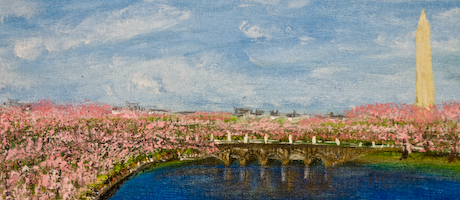By Rachel Muir
Among the paintings are seascapes in blues and greens, a Native American-inspired design in concentric circles of bright primary colors, an oversized Jackson Pollock-esque painting splashed with black and red, and a fanciful world where dinosaurs roam the earth, sky and ocean.
Displayed on five walls across the GW Hospital cafeteria, the artworks were created by local homeless children and adults through art programs at nonprofits Miriam’s Kitchen and Project Create, both housed in Foggy Bottom’s Western Presbyterian Church.
“To increase public awareness and support of programs that assist the homeless and children at-risk, The George Washington University Hospital partnered with Miriam's Kitchen and Project Create to display their artwork and to increase the artists' self confidence,” says Kimberly Russo, chief operating officer for the GW Hospital. “We are fortunate to receive wonderful and creative artwork from these organizations to share with the community members who visit our cafeteria.”
In Foggy Bottom since 1983, Miriam’s Kitchen serves free healthy breakfasts weekdays to more than 200 of the region’s poor and homeless. It also offers a variety of support services, including case management and a series of popular “after-breakfast” programs that include yoga, creative writing, photography, knitting and art therapy.
The art class is one of the longest standing and most popular. It focuses less on instruction in techniques than it does on allowing participants the freedom to create their own works, say Ken and Jackie Durham, Miriam’s Kitchen volunteers who spearhead the program.
One of the Miriam’s Kitchen artists featured in the hospital exhibition, Joseph, is from Sri Lanka. “He has been coming to Miriam’s Kitchen for years,” says Jackie Durham. “He’s very pleasant and nice, and you would never know he’s homeless.” Another, known only as “Mr. C.” is Native American. He drives a taxi, and is starting to travel. A third, Ann Marie, loves childlike, whimsical pictures with dragons and other imaginary creatures.
Project Create offers weekly classes in the visual, literary and performing arts to homeless children whose families live in area shelters--the only arts organization to do so in the city. All classes are led by arts professionals.
She explains that the artwork in the Jackson Pollock style was created by students learning about “rebel artists.” A brightly colored series of collages created with roofing paper was designed to teach children how color, line and shape come together in art. Children also learned how to embed small themes within a larger work by tracing their handprints with pastels and creating a mural collage.
“The children that Project Create serves have led difficult lives, have often lived on the streets, experienced extreme violence, not known where their next meal was coming from or when they would eat, and changed schools countless times,” says Marget Maurer, Project Create executive director.
“For many of our students, Project Create is the only time they have to be creative, explore their artistic abilities and be a ‘normal’ kid,” says Ms. Maurer. “Knowing that their artwork is viewed and appreciated by others is powerful--it validates their abilities, their experiences and allows them to see themselves as true artists.”
Painting enables the Miriam’s Kitchen artists “to express themselves and their feelings and to develop self confidence,” says Ken Durham. “It also contradicts the stereotype that homeless people are not talented or disciplined enough to create a work of art.” When the artists heard their work would be exhibited at the hospital, “they smiled from ear to ear,” he says.
Likewise, having artwork on public display is incredibly meaningful for the children in Project Create. “It’s an amazing opportunity for the students,” says Ms. Maurer. “They like that their creations are in a place of healing and hope that their artwork brings smiles to the faces of the hospital’s staff, patients and guests.”


